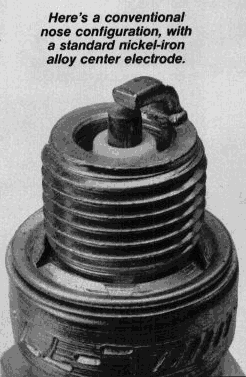Thank you again GSR for having your stuff together and holding such a wealth of knowledge and experience!
Alright, onto the topic... In trying to help educate all of the other readers of a DOHC CB750/900/1100 Mikuni GSXR carb retrofit thread on plug chops and jet sizing,
I found a REALLY REALLY USEFUL diagram and some more supporting info that spelled out something that the other 10+ tutorials and personal instructions hadn't - you are looking for a mere 2mm or so coloration ring on the WOT plug chops, less is obviously lean, more is rich, 2mm hershey bar brown is too rich, tan-brown is good. This diagram really was something I thought belonged on here for reference:
I also read on a Pontiac musclecar website (that failed to mention plug chops!) that you can read the jetting to some degree from the base ring of the spark plug, as shown in the above diagram as well. It said however that the jetting cannot be read from the insulator! Well, maybe that should have read "cannot be read from the insulator without cutting the threads off that shroud the insulator base."
Also, I read a CV carb tuning page on the FactoryPro website that had some useful info that I had never learned. It was geared more towards the newer carbs like the Mikuni BST GSXR style, and the float height actually is the last thing they adjust and is considered part of the idle or low speed adjustment tuning?!? I called BS on that at first, but then read more on gixxer.com about these carbs and that is to some extent true for the later CV's. I also realized from this that on CV's, rpm range is really critical more so than your throttle grip position, because the true throttle position is controlled by the engine's air velocity through the carb which can only be manipulated by your wrist movement. So it says for main jet tuning on CV's, you need to be at 8000+ rpm's. I think there is some merit to that, and my interpretation of that is - "for WOT mains plug chops, ride it up a big long hill like a drag racer and only shift at redline, and then kill it and do the chop" for any CV carb. Some people here would say to do a WOT chop starting at low speed at 2000 rpm at WOT and hit the kill switch at redline. I don't think that's long enough in the actual range we are testing for to give a good reading in my opinion.
Here are some very useful links that I thought I'd add to this post that I have been dropping elsewhere in a thread or two:
http://www.factorypro.com/tech_tunin...m_engines.html (for newer cv's, but lacks the plug chop method)
I think any of you wanting to learn more about modded bike jetting and plug reading should find time to read through all of those. I learned a whole lot from those and other GSR members as well about carb tuning and plug reading in the past year. Before I was just too lazy and thought I could just take some advice on what worked for others who threw in some jets and said "yup, runs better now with pods than with the original jets!"
Thanks again to everyone here, I definitely have a deep appreciation for how collectively knowledgeable this forum and it's members are.
.png)







 .
.

Comment